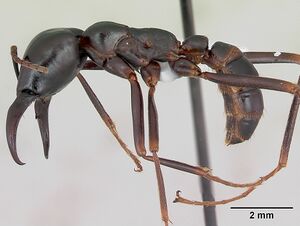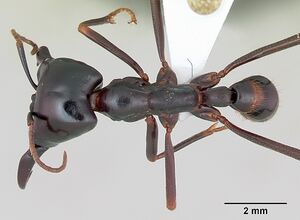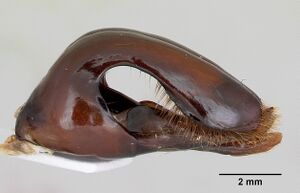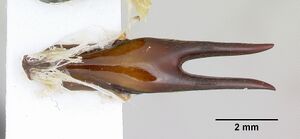Dorylus nigricans
| Dorylus nigricans | |
|---|---|

| |
| Scientific classification | |
| Kingdom: | Animalia |
| Phylum: | Arthropoda |
| Class: | Insecta |
| Order: | Hymenoptera |
| Family: | Formicidae |
| Subfamily: | Dorylinae |
| Genus: | Dorylus |
| Species: | D. nigricans |
| Binomial name | |
| Dorylus nigricans Illiger, 1802 | |
| Subspecies | |
| |
Despite some taxonomic confusion, this species appears to be extremely common and widely distributed across sub-Saharan forests (Taylor et al., 2018).
Identification
A member of the Dorylus nigricans-group.
Distribution
Latitudinal Distribution Pattern
Latitudinal Range: 12.65° to -20.45°.
| North Temperate |
North Subtropical |
Tropical | South Subtropical |
South Temperate |
- Source: AntMaps
Distribution based on Regional Taxon Lists
Afrotropical Region: Benin, Democratic Republic of Congo, Gambia, Guinea-Bissau, Ivory Coast, Liberia, Nigeria, Sierra Leone (type locality), United Republic of Tanzania.
Distribution based on AntMaps
Distribution based on AntWeb specimens
Check data from AntWeb
Countries Occupied
| Number of countries occupied by this species based on AntWiki Regional Taxon Lists. In general, fewer countries occupied indicates a narrower range, while more countries indicates a more widespread species. |

|
Estimated Abundance
| Relative abundance based on number of AntMaps records per species (this species within the purple bar). Fewer records (to the left) indicates a less abundant/encountered species while more records (to the right) indicates more abundant/encountered species. |

|
Biology
Association with Other Organisms
 Explore: Show all Associate data or Search these data. See also a list of all data tables or learn how data is managed.
Explore: Show all Associate data or Search these data. See also a list of all data tables or learn how data is managed.
- This species is a associate (details unknown) for the phorid fly Hexacantherophora cohabitans (a associate (details unknown)) (Quevillon, 2018).
- This species is a associate (details unknown) for the phorid fly Psyllomyia macropygidia (a associate (details unknown)) (Quevillon, 2018).
- This species is a associate (details unknown) for the phorid fly Psyllomyia megophthalma (a associate (details unknown)) (Quevillon, 2018).
- This species is a associate (details unknown) for the phorid fly Psyllomyia sinupennata (a associate (details unknown)) (Quevillon, 2018).
- This species is a associate (details unknown) for the phorid fly Puliciphora karensis (a associate (details unknown)) (Quevillon, 2018).
- This species is a host for the phorid fly Megaselia sp. Q (a parasitoid) (Quevillon, 2018) (encounter mode primary; direct transmission; transmission outside nest).
- This species is a host for the phorid fly Megaselia sp. R (a parasitoid) (Quevillon, 2018) (encounter mode primary; direct transmission; transmission outside nest).
Life History Traits
- Mean colony size: 1,036,800 (Vosseler, 1905; Beckers et al., 1989)
- Foraging behaviour: group hunter (Vosseler, 1905; Beckers et al., 1989)
Castes
Worker
Images from AntWeb
   
| |
| Worker. Specimen code casent0172642. Photographer April Nobile, uploaded by California Academy of Sciences. | Owned by CAS, San Francisco, CA, USA. |
   
| |
| Worker. Specimen code casent0172643. Photographer April Nobile, uploaded by California Academy of Sciences. | Owned by CAS, San Francisco, CA, USA. |
Male
Images from AntWeb
   
| |
| Male (alate). Specimen code casent0172641. Photographer April Nobile, uploaded by California Academy of Sciences. | Owned by CAS, San Francisco, CA, USA. |
Phylogeny
Relationships among selected Dorylus species based on Kronauer et al. (2007).
| Dorylus |
| ||||||||||||||||||||||||||||||||||||||||||||||||||||||||||||||||||||||||||||||||||||||||||||||||||||||||||||||||||||||||||||||||||||
Nomenclature
The following information is derived from Barry Bolton's Online Catalogue of the Ants of the World.
- nigricans. Dorylus nigricans Illiger, 1802: 188 (m.) SIERRA LEONE.
- Type-material: holotype male.
- Type-locality: Sierra Leone.
- Type-depository: unknown (“Hellwig’s collection”).
- Mayr, 1896: 225 (w.); Forel, 1912j: 177 (q.); Santschi, 1930a: 55 (s.w.); Wheeler, G.C. & Wheeler, J. 1984: 268 (l.).
- Combination in D. (Anomma): Emery, 1895j: 710;
- combination in Anomma: Menozzi, 1942: 165.
- Status as species: Fabricius, 1804: 427; Jurine, 1807: 281 (in text); Latreille, 1809: 124; Latreille, 1817b: 556; Lepeletier de Saint-Fargeau, 1835: 228; Shuckard, 1840b: 271; Westwood, 1842: 79; Guérin-Méneville, 1849: 353; Smith, F. 1859b: 2; Mayr, 1863: 408; Roger, 1863b: 41; Gerstäcker, 1871: 355; Ritsema, 1874: 182; Emery, 1892c: liv; Emery, 1892d: 555; Dalla Torre, 1893: 12; André, 1895a: 5; Emery, 1895j: 710; Mayr, 1896: 225; Emery, 1901c: 196 (in key); Forel, 1901h: 47; Mayr, 1904b: 1; Forel, 1907e: 15; Mayr, 1907b: 7; Forel, 1909b: 51; Santschi, 1910c: 352; Emery, 1910b: 12; Stitz, 1910: 128; Forel, 1910c: 248; Forel, 1911d: 362; Forel, 1911f: 275; Santschi, 1912b: 156 (in key); Forel, 1912j: 177; Forel, 1913b: 311; Forel, 1913h: 348; Santschi, 1914b: 62; Santschi, 1914d: 332; Forel, 1914d: 216; Wheeler, W.M. 1922a: 46, 737; Menozzi, 1927f: 356; Santschi, 1930a: 55; Karavaiev, 1931d: 42; Santschi, 1937b: 95; Weber, 1943c: 288; Bernard, 1953b: 218; Raignier & van Boven, 1955: 70, 86 (in key); Bolton, 1995b: 179; Hita Garcia, et al. 2013: 204.
- Distribution: Angola, Cameroon, Congo, Democratic Republic of Congo, Equatorial Guinea, Ethiopia, Ghana, Guinea, Ivory Coast, Kenya, Liberia, Malawi, Mali, Nigeria, Sierra Leone, Somalia, South Sudan, Tanzania (+ Zanzibar), Uganda.
- Current subspecies: nominal plus arcens, burmeisteri, molestus, pallidus, rubellus, sjoestedti, sjostedtiwilverthi, terrificus.
Description
References
- Beckers R., Goss, S., Deneubourg, J.L., Pasteels, J.M. 1989. Colony size, communication and ant foraging Strategy. Psyche 96: 239-256 (doi:10.1155/1989/94279).
- Borowiec, L., Salata, S. 2018. Notes on ants (Hymenoptera: Formicidae) from Gambia (Western Africa). Annals of the Upper Silesian Museum in Bytom, Entomology 26 (online 010), 1-13 (doi:10.5281/ZENODO.1243767).
- Boudinot, B. E., Moosdorf, O. T. D., Beutel, R. G., Richter, A. 2021. Anatomy and evolution of the head of Dorylus helvolus (Formicidae: Dorylinae): Patterns of sex‐ and caste‐limited traits in the sausagefly and the driver ant. Journal of Morphology 282(11), 1616–1658 (doi:10.1002/jmor.21410).
- Boudinot, B.E., Bock, B.L., Weingardt, M., Tröger, D., Batelka, J., LI, D., Richter, A., Pohl, H., Moosdorf, O.T.D., Jandausch, K., Hammel, J.U., Beutel, R. G. 2024. Et latet et lucet: Discoveries from the Phyletisches Museum amber and copal collection in Jena, Germany. Deutsche Entomologische Zeitschrift 711, 111–176 (doi:10.3897/dez.71.112433).
- Cantone S. 2017. Winged Ants, The Male, Dichotomous key to genera of winged male ants in the World, Behavioral ecology of mating flight (self-published).
- Emery, C. 1895l. Die Gattung Dorylus Fab. und die systematische Eintheilung der Formiciden. Zool. Jahrb. Abt. Syst. Geogr. Biol. Tiere 8: 685-778 (page 710, Combination in D. (Anomma))
- Forel, A. 1912k. Die Weibchen der "Treiberameisen" Anomma nigricans Illiger und Anomma Wilverthi Emery, nebst einigen andern Ameisen aus Uganda. Mitt. Naturhist. Mus. Hambg. 29: 173-181 (page 177, queen described)
- Illiger, K. 1802. Neue Insekten. Mag. Insektenkd. (Illiger) 1: 163-208 (page 188, male described)
- Kronauer, D. J. C.; Schöning, C.; Vilhelmsen, L. B.; Boomsma, J. J. 2007. A molecular phylogeny of Dorylus army ants provides evidence for multiple evolutionary transitions in foraging niche. BMC Evolutionary Biology 7: Article 56 (doi:10.1186/1471-2148-7-56).
- Latreille, P.A. 1802. Histoire naturelle des fourmis, et recueil de mémoires et d'observations sur les abeilles, les araignées, les faucheurs, et autres insectes. Paris: Impr. Crapelet (chez T. Barrois), xvi + 445 pp.
- Mayr, G. 1896. Beiträge zur Kenntniss der Insektenfauna von Kamerun. 5. Formiciden gesammelt von Herrn Yngve Sjöstedt. Entomol. Tidskr. 17: 225-252 (page 225, worker described)
- Mbenoun Masse, P.S., Ebolo, G.L.M., Titti, G.E., Mony, R. (2021) Ant species richness, abundance and functional groups along an elevation gradient in Central Cameroon Biodiversity Journal, 2021, 12 1.: 179–194. Biodiversity Journal 12, 179–194 (doi:10.31396/biodiv.jour.2021.12.1.179.194).
- Menozzi, C. 1942a. Formiche dell'isola Fernando Poo e del territorio del Rio Muni (Guinea Spagnola). 24. Beitrag zu den wissenschaftlichen Ergebnissen der Forschungsreise H. Eidmann nach Spanisch-Guinea 1939 bis 1940. Zool. Anz. 140: 164-182 (page 165, Combination in Anomma)
- Raignier, A.; Boven, J. K. A. van. 1955. Étude taxonomique, biologique et biométrique des Dorylus du sous-genre Anomma (Hymenoptera Formicidae). Ann. Mus. R. Congo Belge Nouv. Sér. Quarto Sci. Zool. 2: 1-359 (page 70, see also)
- Santschi, F. 1930a. Description de Formicides éthiopiens nouveaux ou peu connus. V. Bull. Ann. Soc. Entomol. Belg. 70: 49-77 (page 55, see also)
- Taylor, B., Agoinon, N., Sinzogan, A., Adandonon, A., Kouaguou, Y. N., Bello, S., Wargui, R., Anato, F., Ouagoussounon, I., Houngbo, H., Tchibozo, S., Todjihounde, R., Vayssieres, J.F. 2018. Records of ants (Hymenoptera: Formicidae) from the Republic of Benin, with particular reference to the mango farm ecosystem. Journal of Insect Biodiversity 8(1): 6-29 (doi:10.12976/jib/2018.08.1.2).
- Wheeler, G. C.; Wheeler, J. 1984a. The larvae of the army ants (Hymenoptera: Formicidae): a revision. J. Kans. Entomol. Soc. 57: 263-275 (page 268, larva described)
References based on Global Ant Biodiversity Informatics
- André E. 1895. Formicides de l'Ogooué (Congo français). Rev. Entomol. (Caen) 14: 1-5.
- Baroni Urbani C. 1977. Katalog der Typen von Formicidae (Hymenoptera) der Sammlung des Naturhistorischen Museums Basel (2. Teil). Mitt. Entomol. Ges. Basel (n.s.) 27: 61-102.
- Bernard F. 1953. La réserve naturelle intégrale du Mt Nimba. XI. Hyménoptères Formicidae. Mémoires de l'Institut Français d'Afrique Noire 19: 165-270.
- Borowiec L., and S. Salata. 2018. Notes on ants (Hymenoptera: Formicidae) from Gambia (Western Africa). Annals of the Upper Silesian Museum in Bytom Entomology 26: 1-13.
- Borowiec M. L. 2016. Generic revision of the ant subfamily Dorylinae (Hymenoptera, Formicidae). ZooKeys 608: 1–280.
- Emery C. 1892. Voyage de M. Ch. Alluaud dans le territoire d'Assinie (Afrique occidentale) en juillet et août 1886. Formicides. Annales de la Société Entomologique de France 60: 553-574.
- Emery C. 1892. [Untitled. From table of contents: Sur une fourmi nouvelle d'Assinie et remarques sur les Dorylides d'Afrique.]. Ann. Soc. Entomol. Fr. (Bull.) 61:liii-lv.
- Emery C. 1895. Die Gattung Dorylus Fab. und die systematische Eintheilung der Formiciden. Zoologische Jahrbücher. Abteilung für Systematik, Geographie und Biologie der Tiere 8: 685-778.
- Emery C. 1910. Hymenoptera. Fam. Formicidae. Subfam. Dorylinae. Genera Insectorum 102: 1-34.
- Ewuim S. C., M. A. Badejo, and O. O. Ajayi. 1997. Ants of forest and fallow plots in Nigeria. Biotropica 29(1): 93-99.
- Forel A. 1910. Ameisen aus der Kolonie Erythräa. Gesammelt von Prof. Dr. K. Escherich (nebst einigen in West-Abessinien von Herrn A. Ilg gesammelten Ameisen). Zoologische Jahrbücher. Abteilung für Systematik, Geographie und Biologie der Tiere 29: 243-274.
- Forel A. 1913. Formicides du Congo Belge récoltés par MM. Bequaert, Luja, etc. Revue Zoologique Africaine (Brussels). 2: 306-351.
- Forel A. 1913. Quelques fourmis du Musée du Congo Belge (1). Annales de la Société Entomologique de Belgique 57: 347-359.
- Forel A. 1914. Formicides d'Afrique et d'Amérique nouveaux ou peu connus. Bulletin de la Société Vaudoise des Sciences Naturelles 50: 211-288.
- IZIKO South Africa Museum Collection
- Kone M., S. Konate, K. Yeo, P. K. Kouassi, and K. E. Linsenmair. 2012. Changes in ant communities along an age gradient of cocoa cultivation in the Oumé region, central Côte d'Ivoire. Entomological Science 15: 324339.
- Medler J. T. 1980: Insects of Nigeria - Check list and bibliography. Mem. Amer. Ent. Inst. 30: i-vii, 1-919.
- Menozzi C. 1927. Raccolte mirmecologiche dell'Africa orientale conservate nel Museo Civico di Storia Naturale Giacomo Doria di Genova. Parte I. Formiche raccolte dal Marchese Saverio Patrizi nella Somalia italiana ed in alcune località dell'Africa orientale inglese. Annali del Museo Civico di Storia Naturale Giacomo Doria. 52: 356-362.
- Menozzi C. 1930. Formiche della Somalia italiana meridionale. Memorie della Società Entomologica Italiana. 9: 76-130.
- Nousiainen A. 2017. Leaf litter ants in indigenous rainforest and coniferous plantations of the Taita Hills, Kenya. Master Thesis University of Helsinki, 53 pages.
- Santschi F. 1910. Formicides nouveaux ou peu connus du Congo français. Annales de la Société Entomologique de France 78: 349-400.
- Stitz H. 1910. Westafrikanische Ameisen. I. Mitteilungen aus dem Zoologischen Museum in Berlin 5: 125-151.
- Tadu Z., C. Djieto-Lordon, R. Babin, Yede, E. B. Messop-Youbi, and A. Fomena. 2013. Influence of insecticide treatment on ant diversity in tropical agroforestry system: some aspect of the recolonization process. International Journal of Biodiversity and Conservation 5(12): 832-844.
- Taylor B. 1980. Ants of the Nigerian Forest Zone (Hymenoptera: Formicidae). V. Dorylinae, Leptanillinae. Cocoa Research Institute of Nigeria Research Bulletin 8: 1-33.
- Taylor B., N. Agoinon, A. Sinzogan, A. Adandonon, Y. N'Da Kouagou, S. Bello, R. Wargui, F. Anato, I. Ouagoussounon, H. Houngbo, S. Tchibozo, R. Todjhounde, and J. F. Vayssieres. 2018. Records of ants (Hymenoptera: Formicidae) from the Republic of Benin, with particular reference to the mango farm ecosystem. Journal of Insect Biodiversity 8(1): 006–029.
- Weber N. A. 1943. The ants of the Imatong Mountains, Anglo-Egyptian Sudan. Bulletin of the Museum of Comparative Zoology 93: 263-389.
- Weissflog, A., E. Sternheim, W.H.O. Dorow, S. Berghoff and U. Maschwitz. 2000. How to study subterranean army ants: a novel method for locating and monitoring field populations of the South East Asian army ant Dorylus (Dichthadia) laevigatus Smith, 1857 (Formicidae, Dorylinae) with observations on their ecology. Insectes Sociaux 47:317-234
- Wheeler W. M. 1922. Ants of the American Museum Congo expedition. A contribution to the myrmecology of Africa. VIII. A synonymic list of the ants of the Ethiopian region. Bulletin of the American Museum of Natural History 45: 711-1004
- Yeo K., S. Konate, S. Tiho, and S. K. Camara. 2011. Impacts of land use types on ant communities in a tropical forest margin (Oumé - Cote d'Ivoire). African Journal of Agricultural Research 6(2): 260-274.
Categories:
- Pages using DynamicPageList3 parser function
- Need species key
- Tropical
- Phorid fly Associate
- Host of Hexacantherophora cohabitans
- Host of Psyllomyia macropygidia
- Host of Psyllomyia megophthalma
- Host of Psyllomyia sinupennata
- Host of Puliciphora karensis
- Host of Megaselia sp. Q
- Host of Megaselia sp. R
- Species
- Extant species
- Formicidae
- Dorylinae
- Dorylus
- Dorylus nigricans
- Anomma
- Dorylinae species
- Dorylus species
- Need Overview
- Need Body Text

